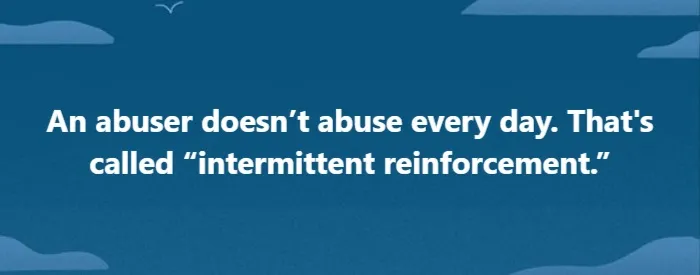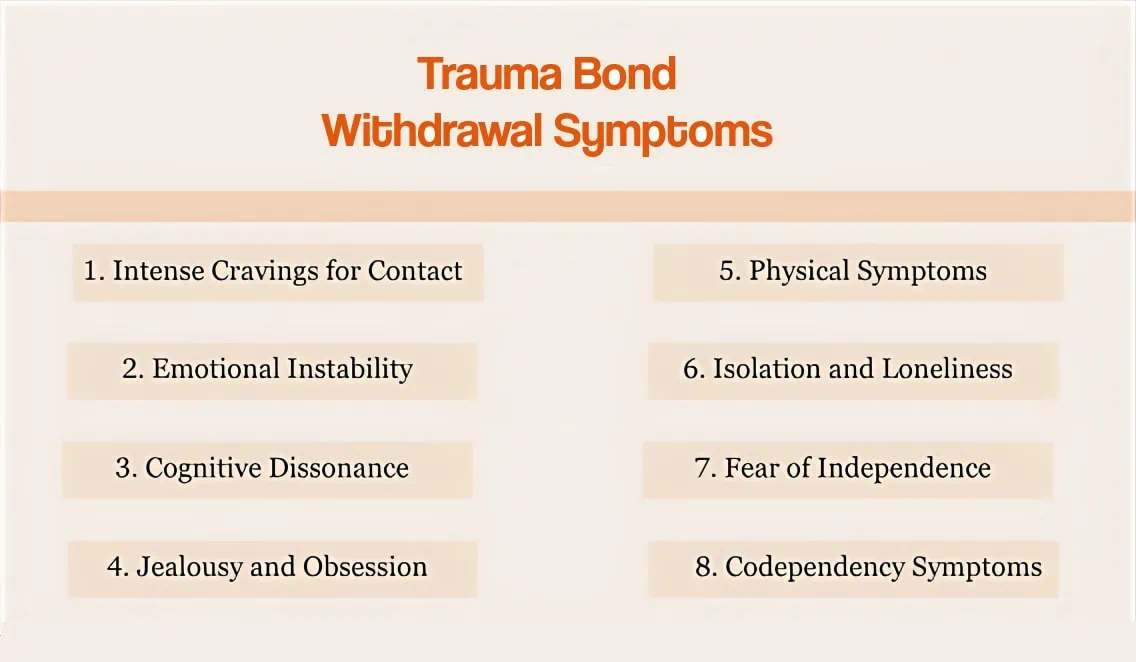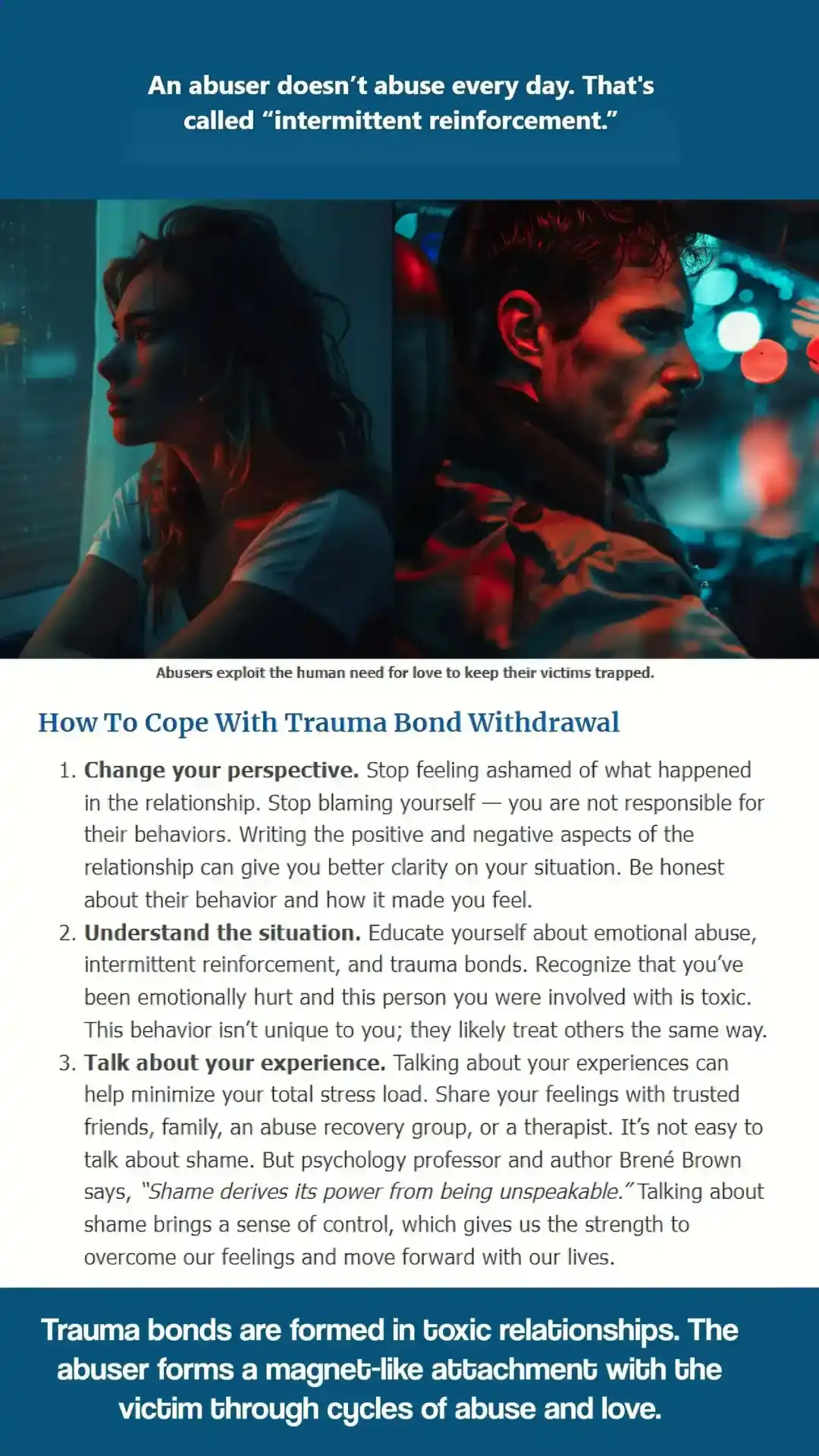Today's Friday • 10 mins read
— By Dr. Sandip Roy.
Sarah hadn’t slept in three days. Every time she started to drift off, she felt a jolt of panic, like she’d forgotten something that would make Mark unhappy.
She knew logically that leaving Mark was the best decision. Yet, the memories of his wild love gnawed at her. She missed those.
She felt a desperate longing to go back to him. The craving felt almost like a physical addiction, painful yet compelling.
Trauma bonds are a result of toxic relationships. Through cycles of abuse and love, the abuser becomes a magnet-like attachment to the victim.
This traps the victim. When they leave, or try to leave, they feel intense psychological and physical side effects. These are trauma bond withdrawal symptoms, much like drug withdrawal symptoms.
- When do they start?
- How does the abuser build them?
- And how can a grown-up victim successfully leave their abuser without feeling these symptoms?
By the way, there are 7 Stages of Trauma Bonding.
Origins of Trauma Bonds
Trauma bonds often originate in childhood. When a child faces neglect, abuse, or inconsistent treatment from a primary caregiver or parent, they develop a trauma bond.
However, couples, friends, and coworkers may form similar bonds. The common denominator is often the same — the more powerful person in the relationship wields control over the other.
How Trauma Bonds Are Built
Toxic relationships are power-imbalanced — one person wields more power than the other. This more powerful person:
- routinely hurts the weaker one physically, mentally, and emotionally, while
- occasionally giving them love and approval.
These occasional, unpredictable shows of love are called intermittent positive reinforcement.

This cyclic battery of mistreatment with periodic rewards of affection (hot-and-cold treatment) builds trauma bonds. This makes the victim feel stuck with the very person who hurts them.
They remain attached to their abuser in the hope that eventually they will turn more loving and caring, and that the mistreatment will go away. Which never happens.
- Trauma-bonded people often gravitate toward other abusive people who show similar patterns of trauma and reinforcement — with the hope that they can fix this abuser this time.
- However, the trauma cycle repeats with this new person, and the victim is back to walking on eggshells, trying to keep their new abuser happy.
- Worse, during the days of mistreatment by this new abuser, they want to go back to their previous abuser, remembering their occasional gestures of love and care.
- These sufferers often become people-pleasers and loyal victims (like Stockholm syndrome).
Trauma Bond In the Brain
The roots of trauma bonding lie in shaping the brain’s survival responses:
- Constant abuse triggers stress and learned helplessness. Victims live in a state of dread, emotional numbness, and hypervigilance. They keep trying to please their abuser to avoid punishment.
- Occasional crumbs of love, kindness, or apology make the victim crave these moments more. These rare moments trigger the brain to release oxytocin, deepening the victim’s desire to seek relief and love when going through abuse and mistreatment.
- Cycles of love and abuse create an imbalance between what people expect and what they get. The victim seeks high validation but receives little. This drives them to form an addictive and loyalty-inducing emotional connection to the trauma-giver.
So, in a way, abusers exploit the brain’s responses to the human need for love and connection to keep their victims trapped. This is why victims want to go back to their abuser.

How To Know You Are Stuck In A Trauma Bond
Signs that you may be stuck in a trauma bond:
- making excuses for the abuser’s behavior
- feeling isolated and alone with people around
- inability to leave the relationship despite knowing it is toxic
- experiencing intense emotional pain when trying to leave the relationship
Features of trauma bonds — emotional dependence, constant fear, warped loyalty, and perverse love.
Trauma-bonded victims live in hope for the abuser’s warmth and relief from their cruelty. While their abusers methodically keep hardening these bonds through novel ways to mistreatment and tranquilize.

Trauma Bond Withdrawal Symptoms
When trying to leave a trauma-bonded relationship, victims often face intense withdrawal effects like those experienced in drug addiction.

- Intense Cravings for Contact. Reason: During a trauma bond, the relationship often becomes a primary source of emotional highs and lows, making the victim crave contact with their abuser to feel a sense of normalcy or relief.
- Emotional Instability. Reason: The highs and lows of a trauma bond create a rollercoaster of emotions, leading to mood swings and emotional instability during withdrawal.
- Cognitive Dissonance. Reason: The disputeing emotions and thoughts about the abuser (love and fear, for instance) create cognitive dissonance, causing confusion and stress.
- Jealousy and Obsession. Reason: Trauma bonds often involve manipulation and control, making the person obsessed with the abuser’s actions and relationships, and jealous of others who might receive the abuser’s attention.
- Physical Symptoms. Reason: Stress and emotional turmoil from withdrawal can manifest physically, causing difficult-to-treat symptoms like headaches, stomach issues, or fatigue.
- Isolation and Loneliness. Reason: Abusers often isolate their victims, and during withdrawal, this isolation becomes more pronounced, leading to feelings of loneliness.
- Fear of Independence. Reason: Trauma bonds create dependency, making the victim afraid of being independent or making decisions on their own.
- Codependency Symptoms. Reason: Trauma bonds often build serious codependency — where each person’s sense of self is tied to the other’s needs and behaviors. The abuser depends on the victim to meet their unrealistic standards and demands. Meanwhile, the victim depends on the abuser to make every little decision about their needs.
- Guilt and Shame. Reason: Victims of trauma bonds often feel guilty for leaving the relationship or ashamed of their involvement in it. These can complicate and obstruct the healing process.
- Flashbacks and PTSD Symptoms. Reason: The trauma in a trauma bond can cause flashbacks and symptoms similar to PTSD, such as hypervigilance, emotional numbness, and nightmares.
- Difficulty Trusting Others. Reason: The betrayal and manipulation make it hard for victims to trust others in future relationships. Some may not get to their original trusting self, even in new, healthy relationships.

How To Handle Your Trauma Bond Withdrawal Symptoms
Trauma bonding is a “psychological spell” that makes you crave going back to them, with the false hope that they will take the blame for their sins, apologize, and change for the better.
Here are some proven ways to cope with your trauma bond withdrawal symptoms:
- Change your perspective. Stop feeling ashamed of what happened in the relationship. Stop blaming yourself — you are not responsible for their behaviors. Write your thoughts and feelings about the traumatic experience for 15–20 minutes on 3–5 occasions, without fussing about grammar or storyline (expressive writing). It can help you sort out your thoughts and show how to move forward.
- Understand the situation. Educate yourself about emotional abuse, intermittent reinforcement, and trauma bonds. Recognize that you’ve been emotionally hurt and this person you were involved with is, and will always be, toxic. This behavior isn’t unique to you; they would treat others the same way.
- Talk about your experience. Talking about your experiences can help minimize your total stress load. Share your feelings with trusted friends, family, an abuse recovery group, or a therapist. It’s not easy to talk about shame. But psychology professor and author Brené Brown says, “Shame derives its power from being unspeakable.” Talking about shame brings a sense of control, which can give us the strength to overcome our feelings and move forward with our lives.
- Prioritize self-care. Refocus on your physical and emotional well-being. Start some activities that relax you, like spending time in nature or trying relaxation techniques like massage or spa. Exercise, eat healthy, and get enough sleep.
- Redesign your life. Change the parts of your life that make you unhealthy and unhappy. Redecorate your living place. Get a new wardrobe or a new hairstyle. Stop people-pleasing. Start saying “No, I can’t do that” and “No, I don’t agree with you” more often. Moving house or city, changing jobs, or finding new people can help rewire your thought patterns.
- Rebuild your social network. Get rid of toxic people in your life. Surround yourself with positive and supportive people. Consider joining a support group — people who survived a similar experience can teach you a lot about their resilience and recovery practices. Consult an abuse therapist for guidance.
- Develop healthy coping mechanisms. Exercise, meditation, and spending time in nature can be helpful. Find a coach to teach you healthy ways to manage stress and anxiety. Don’t fall into bad ways of coping, like smoking, drinking, or using drugs.
- Set boundaries. Stop letting people walk all over you. Learn to set the six boundaries in each of your relationships. Boundaries mean telling a person what you will not tolerate from them. And what you would do if they violate your set boundaries, like limiting or cutting off contact completely.
- Show self-compassion. Treat yourself as your best friend, with kindness, forgiveness, and empathy. Healing takes time. Be patient with yourself and celebrate each little step of your progress. Remember, it’s okay to have setbacks. Take as long as it needs to help your body and mind recover from the trauma bond.
- Focus on the future. An emotional abuser has trained you on “learned helplessness” — unlearning it will take time. Expect setbacks. Don’t beat yourself up over moments of weakness. Stay focused on your future goals and aspirations. Set achievable targets and work towards them. The idea is to get back in the captain’s seat of your lifeboat.
Don’t be afraid or shy to ask for help from professional counselors. Emotional support and therapy can help you calm down and stop your people-pleasing tendencies.
Anoushka’s 5 Steps To Get Over A Trauma Bond
Video Summary:
- Educate yourself about trauma bonds. Understand that you have been emotionally abused and that the person you are bonded to is toxic.
- Stop blaming yourself. Analyze the reality of the situation by writing down the positive and negative aspects of the relationship, to get better clarity on your situation.
- Talk about your experiences. Share your experiences with a therapist, loved ones, or friends to help yourself process your difficult emotions and move on in life.
- Calm your nervous system. Practice activities that help calm your nervous system, such as massage, acupuncture, spending time in nature, or other alternative therapies.
- Start looking after yourself. Prioritize your health — eat properly, get enough sleep, and exercise your body.
Final Thoughts
Breaking a trauma bond with an abuser like a narcissist can be extremely difficult because:
- First, victims often don’t realize that they are in an inescapable situation — embedded trauma makes self-awareness difficult. Only when they get away from their abuser do they realize that something is wrong with them.
- Second, the abuser has most likely socially isolated them so that they have no one to get a second opinion about their feelings and apprehensions.
The main idea is to cut all ties with your abusive partner forever.
Consult a mental health practitioner. Engage in relaxation activities, take a breather from trying new relationships, set boundaries with people, and practice self-compassion.
Don’t rush it. Healing is a gradual process.
√ Also Read: Stockholm Syndrome vs. Trauma Bonding: Similar But Different
√ Please share this with someone.
» You deserve happiness! Choosing therapy could be your best decision.
...
• Disclosure: Buying via our links earns us a small commission.

